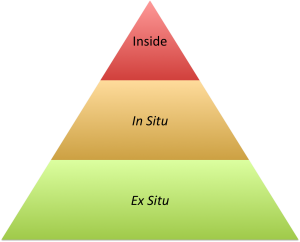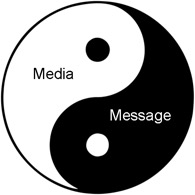The desktop computer had yet to be developed when I started in this profession. Computers in the 1970s were titanic machines that were shoehorned into specially designed, air-conditioned iceboxes to be fed keypunched paper cards. An IBM 38 could do simple arithmetic and little else (your iPhone can do more).
The design and fabrication of interpretive materials at that time involved an astounding amount of manual effort. Drafts were reviewed manually. Crculating a draft document among reviewers for a “sign off” could take months. Photographs were transferred from slide film to internegatives (Kodak no longer even makes internegative film) or were shot on print film and then physically affixed to the print document (think Scotch tape). A pamphlet or printed guide could easily take several months to produce. Catch a mistake after spending the night pecking away on the IBM? Pull out the bottle of Liquid Paper and dab away.
Digital technology has radically changed our capabilities. But what about our skills? Have these technological advances improved our skill set as well?
We have the ability to design an entire interpretive sign on a computer, but what if we know little about the art of graphic design? We can integrate photographs with the flip of a switch, but a poor quality image still distracts and degrades the end product. We have a marvelous selection of tools at our fingertips, but they are worthless unless we now how to use them.
Exactly what does an interpreter need to succeed? Which skills are necessary to go guerrilla?
Going guerrilla demands a degree of self-containment and self-reliance.
Let’s begin with one of the elementary premises of guerrilla interpretation. Going guerrilla demands a degree of self-containment and self-reliance. The more self-contained the interpreter, the better the chances of success in the profession. A self-contained interpreter is like a gonzo journalist, personally involved in the creation of every interpretive message, plan, and enhancement.
There is rarely a situation where some collaboration isn’t required. But, interpretation at an accelerated pace while retaining thematic integrity demands that much of the work be done by the same person or the same small team. Going guerrilla demands a mastery of interpretation.
Most people come to the profession from the mastery of a resource rather than through a mastery of interpretation.
Most people come to the profession from the mastery of a resource rather than through a mastery of interpretation. Resource interpreters begin as biologists, ecologists, historians, archeologists, and educators, and thus carry a deep knowledge of a specific field. Most enter interpretation through the back door.
Mastery of a specific resource or field is of limited value in guerrilla interpretation. A guerrilla interpreter is confronted and challenged by array of resources, often in the same project. Consider the interpretation of a scenic byway. An interpreter will be faced with an eclectic (and disparate) range of sites and interpretive possibilities along the designated route. The challenge for the interpreter is to find the thematic linkages that will pull them together into a coherent whole.
Guerrilla interpretation is a rapid fire, efficient, self-contained approach that operates at the nexus of the new digital technologies and an interpreter’s skills.
Additionally, while knowledge of a field certainly helps with the initial research and inventory work, that is only one skill that is needed in the wider set. Experts can always be found to assist with research. What is critical for a guerrilla interpreter is the ability to work across the broadest array of topics, and to have the skills to massage these disparate points of interest into a cohesive interpretive strategy. The key is to see the byway with an guerrilla’s eye.
What are the specific skills that are critical to such an interpreter? Start with interpretive planning, interpretive writing, photography, illustration, graphic design, web design, and social media. To be blunt, research isn’t one of them. The academic community provides a wealth of research material to review and incorporate. But, there is a limit to how much research can be incorporated into the work. More importantly, there is a limit to how much needs to be incorporated.
You need to be fluent in all of these skills, although you may only master a few. If required, you should be capable of working with all of these skills independently to developed interpretive enhancements. If needed, you should be able to organize the interpretive strategy, write the content, photograph the subjects, design the signs, and engineer the blog. This gives you the freedom to “go guerrilla,” and literally interpret on the fly.
Guerrilla interpretation is a rapid fire, efficient, self-contained approach that operates at the nexus of the new digital technologies and an interpreter’s skills. Gonzo interpreters may spend the day in the field, then build a blog in their hotel room overnight. Compressed work flows give advantages in both time and cost.
All of this depends on technology and skills. Technology is bought; skills are taught. Which skills are critical to interpreters remaining relevant in the 21st century?
Technology is bought; skills are taught.
Here is a basic skill list that is used in guerrilla interpretation. Skills such a facility design and project analysis that may or may not be creative activities are therefore not included.
- Research
- Inventory
- Interpretive Design
- Graphic Design
- Illustration (including photography)
- Interpretive Writing
- Interpretive Technologies
- Interpretive Planning
- Personal Interpretation
This is the guerrilla skill set, at a minimum. With these skills you can efficiently and expediently develop an interpretive program from inventory to product development.
Are we teaching new interpreters these skills? No. We may hit the high points, but, for the most part, we spend more time on Maslow. A new interpreter can learn Maslow in about five minutes if he or she hasn’t the common sense to know these basic human needs already. But interpretive photography? That skill takes work. That skill takes time.
A guerrilla interpreter is a practitioner, not an academician or a theoretician. Guerrilla interpreters work with people who are practitioners as well. Clients are interested in how interpretation will aid their efforts on the ground, not in journals. This is not to say that the research isn’t important, or that you shouldn’t try to keep abreast of the latest results. The research, however, is at best a means to an end.
An analogous field is journalism (and, not surprisingly, many early interpreters such as Freeman Tilden came from journalism). Journalists study editorial writing, headlines, ethics, and the like. Journalism is a craft, and it is taught by craftsmen.
Interpretation is a craft as well. As such, interpretation involves not just skills but the creativity of art as well (as in artisan). As in any art, there are skills that must be learned before the artist can begin to effectively express themselves through their work.
A guerrilla interpreter believes in the healing powers of practice. Interpreters become better interpreters by interpreting.
A guerrilla interpreter believes in the healing powers of practice. Interpreters become better interpreters by interpreting. Henri Cartier-Bresson, the great photojournalist, once advised those becoming photographers to take 10,000 photos, throw them away, and start again. The same is true for interpretation. Write a few dozen interpretive strategies, throw them away, and start again.
Hone your skills. Practice your craft. These are skills that practitioners need to become the best at their crafts and to stretch the horizons of what is possible.
![Should You Build a Mobile App or Mobile Website? [infographic by MDG Advertising] Should You Build a Mobile App or Mobile Website? [infographic by MDG Advertising]](http://www.mdgadvertising.com/blog/wp-content/uploads/2013/06/should-you-build-a-mobile-app-or-mobile-website.png)



![It’s All About the Images [infographic by MDG Advertising] It’s All About the Images [infographic by MDG Advertising]](http://www.mdgadvertising.com/blog/wp-content/uploads/2012/05/its-all-about-images-infographic_1000.png)
